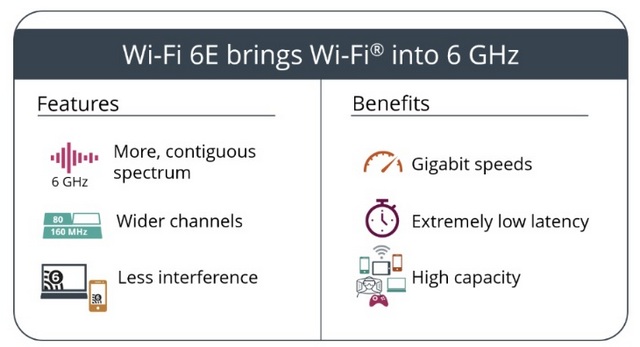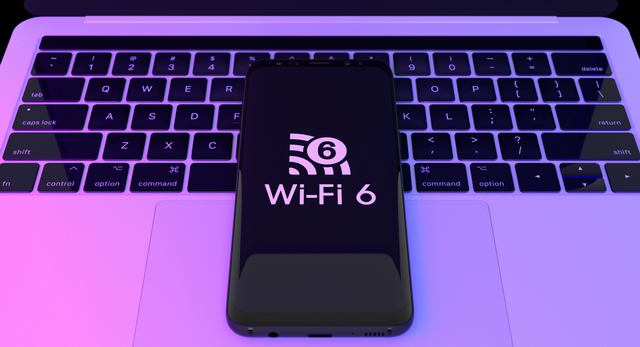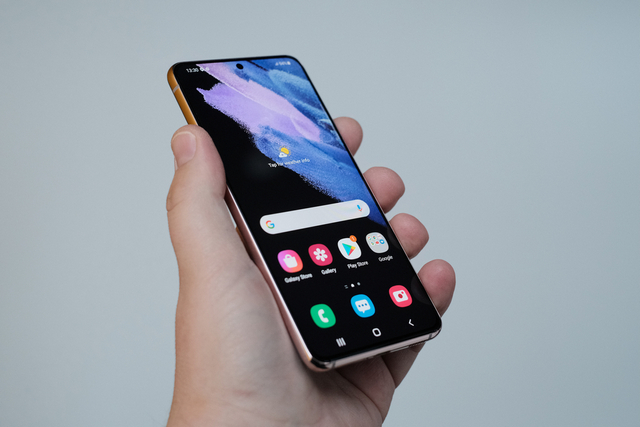What is Wi-Fi 6E: Difference Between Wi-Fi 6 and Wi-Fi 6E?
According to the Market Intelligence and Consulting Institute, more than 3 billion Wi-Fi devices are shipped each year – a figure that is expected to rise in the coming years. Wi-Fi 6E is expected to add a new dimension to the age-old technology, bringing new opportunities and new challenges. Here, we will discuss all of that, but we will start off with an explainer on what is Wi-Fi 6E and the difference between Wi-Fi 6 and Wi-Fi 6E.
What is Wi-Fi 6E?
Wi-Fi 6E is the latest Wi-Fi standard specified by the Wi-Fi Alliance – the organization that owns and operates the “Wi-Fi” brand and logo. It is not a new specification, but an extended designation over and above Wi-Fi 6 and, will enable communication using the 6GHz band in addition to the existing 2.4GHz and 5GHz Wi-Fi standards. Wi-Fi 6E is the same standard as Wi-Fi 6 in terms of specifications, but with an extended spectrum that will include 6GHz+ frequencies, thereby adding higher throughput and lower latency (the ‘E’ in 6E stands for ‘Expanded’). Chart Courtesy: Wi-Fi Alliance Wi-Fi 6E will support an additional 1200 MHz of spectrum in the 6GHz band, enabling routers and other devices to operate in 14 additional 80 MHz channels and 7 additional 160 MHz channels. The broader spectrum will not only simplify network design, but also add higher throughput and wider channels, thereby increasing Wi-Fi speeds and lowering latency. It will also eventually eliminate the need to support legacy devices, reducing network congestion, especially in high-load areas, such as office buildings, stadiums, conferences and more. The extended spectrum capacity is also expected to enhance user experience by creating more capable Wi-Fi devices that will not only be faster than their regular Wi-Fi 802.11ax counterparts, but also more reliable, thanks to the ability to support optimum connections even in high-density. They will also be better at high-bandwidth applications, such as video streaming, videoconferencing, and more. This should allow enterprises, service providers and event organizers to provide faster and more reliable Wi-Fi networks.
What is Wi-Fi 6?
To better understand Wi-Fi 6E, we will first need to understand what is Wi-Fi 6 and what it promises to improve over Wi-Fi 5 (Wi-Fi 802.11ac). Originally announced in late 2019, Wi-Fi 6 is an update over Wi-Fi 5 and, is designed to operate in license-exempt bands between 1 and 6GHz. In what has been described as the “biggest leap in wireless technology” in twenty years, the Wi-Fi Alliance is slated to publish the Wi-Fi 6 (IEEE 802.11ax) standard in February 2021, bringing with it a series of improvements to address some of the limitations in the older generations.
The new standard is said to offer 4x the throughput of Wi-Fi 5, although, the nominal data rate is only about 37% faster. Latency, however, is down 75%, making it more suited to real-time applications, like gaming. It also promises to improve spectrum efficiency by introducing better power-control methods to avoid interference with neighboring networks. It will also add MIMO (Multiple Input and Multiple Output) and MU-MIMO (Multi-User MIMO) to further increase throughput, as well as security protocols, such as Target Wake Time and WPA3.
Difference Between Wi-Fi 6 and Wi-Fi 6E (Wi-Fi 6 vs Wi-Fi 6E)
As mentioned already, Wi-Fi 6E is an amendment to the Wi-Fi 6 standard, bringing faster speeds and lower latency. Wi-Fi 6E is otherwise identical to Wi-Fi 6 in terms of specifications, with the exception that 6E hardware can tap into new unlicensed wireless blocks in the 6GHz spectrum. In the US, the inclusion of the new spectrum will drastically increase available channels by up to 7 times for entry-level devices, making 160MHz channels more usable. There’s currently only 500 MHz of spectrum available for Wi-Fi in the 5GHz band (and a meager 70MHz in 2.4GHz), so the addition of 1200MHz will see a significant jump in both quality and reliability of Wi-Fi networks, especially in crowded areas. Here are the major differences between Wi-Fi 4, Wi-Fi 5, Wi-Fi 6 and Wi-Fi 6E at a glance:
Wi-Fi 6E Applications and Benefits
Wi-Fi 6E will support everything that Wi-Fi 6 offers, but will bring tons of new spectrum to ensure that your Wi-Fi devices do not have to share the airwaves with those of your neighbors’. Key benefits of Wi-Fi 6E include higher data rates, increased capacity, lower latency, sustained performance with multiple connected devices and improved power efficiency, making it an overall better choice for IoT. Being an addendum to the Wi-Fi 6 specification, Wi-Fi 6E is also expected to offer all the advantages of Wi-Fi 6, including enhanced performance to emerging applications such as virtual and augmented reality (VR and AR) used in e-Learning, telepresence and healthcare. It is also meant to provide carriers and public Wi-Fi operators with more capabilities to support advanced connectivity in retail, stadiums, and transportation hubs. It will also bring several key improvements over 802.11ac. Because it addresses frequency bands between 1GHz and 6GHz, it will also operate in the unlicensed 2.4 GHz band, something that Wi-Fi 802.11ac (Wi-Fi 5) fails to do. Another major benefit of Wi-Fi 6E is that the 6GHz range will not suffer from interference from other non-Wi-Fi networks and devices in the 2.4 and 5GHz bands.
Wi-Fi 6E Disadvantages
While the use of the 6GHz spectrum will provide faster speeds with lower latency, it is also expected to offer slightly less range compared to the 2.4- and 5GHz bands. The higher frequency band is also expected to be obstructed more easily by physical barriers, like walls and trees, between the router and the device. Another factor that might potentially inhibit the fast take-off for the new technology is pricing. Wi-Fi 6 routers are already more expensive than their Wi-Fi 5 counterparts, and devices with 6E support are expected to be even more so. However, we should expect prices to come down as the technology becomes more mainstream in the coming years.
Wi-Fi 6E Speed and Latency
The theoretical maximum data throughput of Wi-Fi 6 is 9.6 Gbps (1.2 GB/s), while Wi-Fi 5 tops out at 6.9 Gbps. This suggests an increase of more than 40%. According to Qualcomm, the maximum theoretical speed of its Wi-Fi 6E mobile phone chip is 3.6Gbps. Meanwhile, the new technology also has an ultra-low latency of less than 3 milliseconds, suggesting an improvement over earlier generations. The difference is even more pronounced in dense environments, where the latency is lower by more than 8 times.
Wi-Fi 6E Security
Security and interoperability are at the heart of Wi-Fi 6E. It not only supports all available license-exempt frequencies between 1GHz and 6GHz, but also offers cutting-edge security protocols, including Tartget Wake Time and WPA 3.
Wi-Fi 6E Availability
Brazil, Chile, the European Union (EU), Japan, Mexico, South Korea,Taiwan, the UAE, the UK and the US, are all delivering 6GHz unlicensed spectrum to their citizens. The US Federal Communications Commission (FCC) has also recently authorized the first Wi-Fi device for use in the 6GHz spectrum band after voting in April 2020 to open up spectrum in the 6GHz band (5.925–7.125 GHz) for unlicensed use.
Wi-Fi 6E Release Date and Devices
Wi-Fi 6E is expected to be officially detailed next month. According to Kevin Robinson, Senior Vice President of Marketing at WFA, more than 338 million Wi-Fi 6E devices are expected to enter the market in 2021. The Galaxy S21 Ultra is the first smartphone in the world to support Wi-Fi 6E, thanks to the BCM4389 chip from Broadcom. Asus, Broadcom, Intel and Qualcomm have also announced Wi-Fi 6E products that will start shipping this year. Samsung Galaxy S21 Ultra – The First Smartphone With Wi-Fi 6E Support While there are no other WiFi 6E supported devices right now, companies have been shipping WiFi 6 devices for a while now.
Android
Most major Android manufacturers have been offering models with Wi-Fi 6 support since at least last year. The list includes the Samsung Galaxy Fold 2, Galaxy S21 series, Galaxy S20 series, Galaxy Note 10 series, Asus ROG Phone 3, Asus ZenPhone 7 series, Lenovo Legion Pro, OnePlus 8/ 8 Pro, Xiaomi Black Shark 3, Redmi K30 Pro/ Ultra and more.
iPhone and Mac
Apple first incorporated Wi-Fi 6 support in its iPhone 11 lineup in 2019. It has since added the new technology to the iPhone 12 series, as well as the new iPad Pro and the M1 MacBooks. the devices that lack support for the new technology include the low-cost iPad, iPad Mini and the Intel-powered Macs.
Routers
Notable Wi-Fi 6 routers include the LinkSys MX10 Velop, Netgear Nighthawk MK62, ASUS RT-AX92U AX6100, etc. We expect the first lot of Wi-Fi 6E routers from Netgear, Intel, TP-Link, Asus and Xiaomi to start hitting the market once the standard is officially announced this year. Here is a list of all the WiFi 6E routers that are officially announced:
Nighthawk RAXE500 TP-Link Deco X96 TP-Link Archer AX96 Linksys AXE8400 ASUS ROG Rapture GT-AXE11000
How Fast is WiFi 6E?
The theoretical maximum data throughput of Wi-Fi 6 is 9.6 Gbps (1.2 GB/s), which is an increase of more than 40% over WiFi 5. According to Qualcomm, the maximum theoretical speed of its WiFi 6E mobile phone chip is 3.6Gbps and the maximum theoretical speed of the router chip ranges from 5.4Gbps to 10.8Gbps. The new technology also has an ultra-low latency of less than 3 milliseconds.
Are There Any WiFi 6E Routers?
Intel has already started shipping the AX210 Wi-Fi 6 adapter with support for Wi-Fi 6E. Broadcom, Caleno and Qualcomm have also announced their first Wi-Fi 6E chips that have already started finding their way to phones like the Galaxy S21 Ultra. Routers and other gadgets will also start supporting the new standard this year.
Does WiFi 6 Benefit Older Devices?
To enjoy the benefits of Wi-Fi 6, you have to upgrade your access points (routers, etc). Older devices that do not have the Wi-Fi 6 hardware cannot be updated to support Wi-Fi 6/ 6E.
Is it Worth Buying a Wi-Fi 6 Router?
If you’ve already updated to Wi-Fi 6-capable hardware, it doesn’t make sense at this stage to buy any new hardware. However, folks who are planning to upgrade their Wi-Fi 4 and 5 networks soon, might be better off holding off until 6E hardware becomes widely available.
Does Wi-Fi 6 Have Better Range Than Wi-Fi 5?
The use of the 6GHz spectrum will provide faster speeds with lower latency, but is also expected to offer slightly less range compared to 2.4 and 5GHz bands. Overall, however, the addition of 1200MHz of spectrum will enable routers and other devices to operate in 14 additional 80 MHz channels and 7 additional 160 MHz channels.
What’s the Difference Between Wi-Fi 5 and Wi-Fi 6?
Compared to Wi-Fi 5, Wi-Fi 6 has some major advantages, including speed, the introduction of MU-MIMO and OFDMA (Spatial Multiplexing). While the theoretical maximum speeds of Wi-Fi 6 can touch 9.6 Gbps, while WiFi 5 can only hit up to 6.9 Gbps. As for MU-MIMO, it will enable one base station to serve multiple mobile terminals at the same time, thereby solving the problem of network congestion. Finally, OFDMA will improve on FDMA by enabling multiple devices to transmit data at once. It will do so by sub-diving the frequency band instead of sending and receiving data sequentially.
Does PS5 Support WiFi 6?
Yes, the PlayStation 5 comes with a Wi-Fi 6 wireless antenna and also supports Bluetooth 5.1.
How Will I Know if a Device Supports WI-FI 6E?
The Wi-Fi Alliance (WFA) already has a ‘Wi-Fi Certified 6’ program, enabling OEMs and vendors to advertise their routers, laptops, smartphones and other client-side devices as compatible with the new standard. Once the Wi-Fi 6E standard is finalized, the organization will also announce a similar program for Wi-Fi 6E to let buyers know which devices support the technology.
What to Remember Before Updating to Wi-Fi 6/6E?
While Wi-Fi 6 will be a major update over Wi-Fi 5, the benefits of Wi-Fi 6E is not enough for most people to justify an upgrade over Wi-Fi 6. However, if you face issues such as device density, latency, throughput or interference, it might be something worth looking at. Enterprises, however, may reap the benefits of upgrading portions of their WLAN with Wi-Fi 6E access points if it is planning to add hundreds or thousands of 6E-capable IoT devices to its network.
The Fastest, Most Reliable Wi-Fi Standard is Just Around the Corner
Wi-Fi is an indispensable part of our everyday lives. However, we often take it for granted, without bothering to know about the technology behind it. Now that you know more about Wi-Fi and its latest specifications, it should help you make informed decisions when you buy your next Wi-Fi-enabled device, including smartphones, laptops, routers and more. So, are you already using a Wi-Fi 6 device or planning to buy a Wi-Fi 6E router any time soon? Let us know in the comments down below.


